Why Consider Geomorphology in River Rehabilitation?
Abstract
:1. Introduction
2. Reflecting on Geomorphology to Improve Rivers: The Emerging Field of River Repair
3. Understanding Alterations and Orders of Magnitude of Active Processes
4. Pre-Project Assessment: Evaluate Risks, Gains, and Potential Channel Responsiveness before Acting
5. Post-Rehabilitation Project Assessment: Evaluate Success and Provide Predictive Models for Rehabilitation Design
5.1. Is Rehabilitation a Success? What Can a Monitoring Framework Tell Us?
- Validate the grain size of the replenished sediment mass that can be effectively transported by the stream once rehabilitated, and which is estimated from hydraulics models and flow records;
- Estimate the effects of the rehabilitation on aquatic habitats in terms of improved bed surface area and sustainability;
- Estimate, improve, and validate the volumes needed and the necessary frequency for reinjection operations.
5.2. The Feedback Loop of Post-Rehabilitation Monitoring Data: Feeding Predictive Response Models
5.3. A New Monitoring Era Is Emerging with Remote Sensing Information
6. Targeted Rehabilitation Using Upscaled Geomorphology
7. Conclusions
Author Contributions
Funding
Data Availability Statement
Acknowledgments
Conflicts of Interest
References
- Hilderbrand, R.H.; Watts, A.C.; Randle, A.M. The Myths of Restoration Ecology. Ecol. Soc. 2005, 10. Available online: https://www.jstor.org/stable/26267738 (accessed on 10 May 2020). [CrossRef] [Green Version]
- Brierley, G.J.; Fryirs, K.A. Moves toward an Era of River Repair. In River Futures: An Integrative Scientific Approach to River Repair; Island Press: London, UK, 2008; pp. 3–15. [Google Scholar]
- Loire, R.; Piégay, H.; Malavoi, J.-R.; Kondolf, G.M.; Bêche, L.A. From Flushing Flows to (Eco) Morphogenic Releases: Evolving Terminology, Practice, and Integration into River Management. Earth-Sci. Rev. 2021, 213, 103475. [Google Scholar] [CrossRef]
- Piégay, H.; Naylor, L.A.; Haidvogl, G.; Kail, J.; Schmitt, L.; Bourdin, L. Integrative River Science and Rehabilitation: European Experiences. In River Futures: An Integrative Scientific Approach to River Repair; Island Press: London, UK, 2008; pp. 201–219. [Google Scholar]
- Logar, I.; Brouwer, R.; Paillex, A. Do the Societal Benefits of River Restoration Outweigh Their Costs? A Cost-Benefit Analysis. J. Environ. Manag. 2019, 232, 1075–1085. [Google Scholar] [CrossRef] [PubMed]
- Morandi, B.; Cottet, M.; Piégay, H. River Restoration: Political, Social, and Economic Perspectives; John Wiley & Sons: Hoboken, NJ, USA, 2021. [Google Scholar]
- Kaiser, N.N.; Feld, C.K.; Stoll, S. Does River Restoration Increase Ecosystem Services? Ecosyst. Serv. 2020, 46, 101206. [Google Scholar] [CrossRef]
- Brousse, G. Efficacité des Travaux de Restauration et Résilience des Rivières Torrentielles Altérées. Ph. D. Thesis, Université de Paris, Paris, France, 2020. [Google Scholar]
- Zeug, S.C.; Sellheim, K.; Watry, C.; Rook, B.; Hannon, J.; Zimmerman, J.; Cox, D.; Merz, J. Gravel Augmentation Increases Spawning Utilization by Anadromous Salmonids: A Case Study from California, USA. River Res. Appl. 2014, 30, 707–718. [Google Scholar] [CrossRef]
- Barbedo, J.; Miguez, M.; Van Der Horst, D.; Marins, M. Enhancing Ecosystem Services for Flood Mitigation: A Conservation Strategy for Peri-Urban Landscapes? Ecol. Soc. 2014, 19. [Google Scholar] [CrossRef]
- Kondolf, G.; Smeltzer, M.W.; Railsback, S.F. Design and Performance of a Channel Reconstruction Project in a Coastal California Gravel-Bed Stream. Environ. Manag. 2001, 28, 761–776. [Google Scholar] [CrossRef]
- Simon, A.; Doyle, M.; Kondolf, M.; Shields, F.D.; Rhoads, B.; McPhillips, M. Critical Evaluation of How the Rosgen Classification and Associated “Natural Channel Design” Methods Fail to Integrate and Quantify Fluvial Processes and Channel Response1; Wiley Online Library: Hoboken, NJ, USA, 2007. [Google Scholar]
- Roni, P.; Hanson, K.; Beechie, T. Global Review of the Physical and Biological Effectiveness of Stream Habitat Rehabilitation Techniques. N. Am. J. Fish. Manag. 2008, 28, 856–890. [Google Scholar] [CrossRef]
- Bradshaw, A.D. Underlying Principles of Restoration. Can. J. Fish. Aquat. Sci. 1996, 53, 3–9. [Google Scholar] [CrossRef]
- Boon, P.J. River Restoration in Five Dimensions. Aquat. Conserv. Mar. Freshw. Ecosyst. 1998, 8, 257–264. [Google Scholar] [CrossRef]
- Bernhardt, E.S.; Palmer, M.A.; Allan, J.D.; Alexander, G.; Barnas, K.; Brooks, S.; Carr, J.; Clayton, S.; Dahm, C.; Follstad-Shah, J.; et al. Synthesizing U.S. River Restoration Efforts. Science 2005, 308, 636–637. [Google Scholar] [CrossRef] [PubMed]
- Morandi, B.; Piégay, H.; Lamouroux, N.; Vaudor, L. How Is Success or Failure in River Restoration Projects Evaluated? Feedback from French Restoration Projects. J. Environ. Manag. 2014, 137, 178–188. [Google Scholar] [CrossRef] [PubMed]
- Piégay, H.; Kondolf, M.G.; Sear, D.A. Integrating Geomorphological Tools to Address Practical Problems in River Management and Restoration. In Tools in Fluvial Geomorphology; Wiley: Hoboken, NJ, USA, 2016; pp. 505–532. [Google Scholar]
- Schumm, S.A.; Lichty, R.W. Time, Space, and Causality in Geomorphology. Am. J. Sci. 1965, 263, 110–119. [Google Scholar] [CrossRef]
- Lane, S.N.; Richards, K.S. Linking River Channel Form and Process: Time, Space and Causality Revisited. Earth Surf. Process. Landf. J. Br. Geomorphol. Group 1997, 22, 249–260. [Google Scholar] [CrossRef]
- Jungwirth, M.; Muhar, S.; Schmutz, S. Re-Establishing and Assessing Ecological Integrity in Riverine Landscapes. Freshw. Biol. 2002, 47, 867–887. [Google Scholar] [CrossRef]
- Wang, S. Resource-Oriented Water Management: Towards Harmonious Coexistence Between Man and Nature; Iwra International Water Resources ASSN; WaterPower Press: Beijing, China, 2002. [Google Scholar]
- Dufour, S.; Piégay, H. From the Myth of a Lost Paradise to Targeted River Restoration: Forget Natural References and Focus on Human Benefits. River Res. Appl. 2009, 25, 568–581. [Google Scholar] [CrossRef]
- Petts, G.E.; Moeller, H.; Roux, A.L. Historical Change of Large Alluvial Rivers: Western Europe; Wiley: Hoboken, NJ, USA, 1989. [Google Scholar]
- Aronson, J.; Floret, C.; Le Floc’h, E.; Ovalle, C.; Pontanier, R. Restoration and Rehabilitation of Degraded Ecosystems in Arid and Semi-Arid Lands. I. A View from the South. Restor. Ecol. 1993, 1, 8–17. [Google Scholar] [CrossRef]
- Brierley, G.J.; Fryirs, K.A. River Futures: An Integrative Scientific Approach to River Repair; Island Press: Washington, DC, USA, 2008. [Google Scholar]
- Morandi, B.; Piégay, H. River Restoration in France. Changes in Definitions and Methods over Time and Space. Outlook for the Future. Office Français de la Biodiversité: Paris, France, 2017; p. 28. [Google Scholar]
- Piégay, H.; Chabot, A.; Le Lay, Y.-F. Some Comments about Resilience: From Cyclicity to Trajectory, a Shift in Living and Nonliving System Theory. Geomorphology 2018, 367, 106527. [Google Scholar] [CrossRef]
- García, J.H.; Ollero, A.; Ibisate, A.; Fuller, I.C.; Death, R.G.; Piégay, H. Promoting Fluvial Geomorphology to “Live with Rivers” in the Anthropocene Era. Geomorphology 2021, 380, 15. [Google Scholar] [CrossRef]
- Mika, S.; Hoyle, J.; Kyle, G.; Howell, T.; Wolfenden, B.; Ryder, D.; Keating, D.; Boulton, A.; Brierley, G.; Brooks, A.P. Inside the “Black Box” of River Restoration: Using Catchment History to Identify Disturbance and Response Mechanisms to Set Targets for Process-Based Restoration. Ecol. Soc. 2010, 15. Available online: http://www.jstor.org/stable/26268202 (accessed on 10 May 2020). [CrossRef]
- Grabowski, R.C.; Surian, N.; Gurnell, A.M. Characterizing Geomorphological Change to Support Sustainable River Restoration and Management. Wiley Interdiscip. Rev. Water 2014, 1, 483–512. [Google Scholar] [CrossRef]
- Eschbach, D.; Schmitt, L.; Imfeld, G.; May, J.-H.; Payraudeau, S.; Preusser, F.; Trauerstein, M.; Skupinski, G. Long-Term Temporal Trajectories to Enhance Restoration Efficiency and Sustainability on Large Rivers: An Interdisciplinary Study. Hydrol. Earth Syst. Sci. 2018, 22, 2717–2737. [Google Scholar] [CrossRef] [Green Version]
- Williams, G.P.; Wolman, M.G. Downstream Effects of Dams on Alluvial Rivers; US Government Printing Office: Washington, DC, USA, 1984; Volume 1286. [Google Scholar]
- Surian, N.; Rinaldi, M. Morphological Response to River Engineering and Management in Alluvial Channels in Italy. Geomorphology 2003, 50, 307–326. [Google Scholar] [CrossRef]
- Downs, P.W.; Piégay, H. Catchment-Scale Cumulative Impact of Human Activities on River Channels in the Late Anthropocene: Implications, Limitations, Prospect. Geomorphology 2019, 338, 88–104. [Google Scholar] [CrossRef]
- Rollet, A.J.; Piégay, H.; Dufour, S.; Bornette, G.; Persat, H. Assessment of Consequences of Sediment Deficit on a Gravel River Bed Downstream of Dams in Restoration Perpectives: Application of a Multicriteria, Hierarchical Ans Spacially Explicit Diagnosis: Sediment Deficit Consequences. River Res. Appl. 2013, 30, 939–953. [Google Scholar] [CrossRef]
- Muhar, S.; Arnaud, F.; Aschwanden, H.; Binder, W.; Broggi, M.; Greimel, F.; Knopper, F.; Michor, K.; Morandi, B.; Piégay, H. Restoration—New Life for Alpine Rivers 2019. Available online: https://www.researchgate.net/publication/338671171_62_Restoration_-_New_life_for_Alpine_rivers (accessed on 10 May 2020).
- Ham, D.G.; Church, M. Bed-Material Transport Estimated from Channel Morphodynamics: Chilliwack River, British Columbia. Earth Surf. Process. Landf. J. Br. Geomorphol. Res. Group 2000, 25, 1123–1142. [Google Scholar] [CrossRef]
- Brewer, P.A.; Passmore, D.G. Sediment Budgeting Techniques in Gravel-Bed Rivers. Geol. Soc. Lond. Spec. Publ. 2002, 191, 97–113. [Google Scholar] [CrossRef]
- Gaeuman, D.; Andrews, E.D.; Krause, A.; Smith, W. Predicting Fractional Bed Load Transport Rates: Application of the Wilcock-Crowe Equations to a Regulated Gravel Bed River. Water Resour. Res. 2009, 45. [Google Scholar] [CrossRef]
- Lauer, J.W.; Viparelli, E.; Piégay, H. Morphodynamics and Sediment Tracers in 1-D (MAST-1D): 1-D Sediment Transport That Includes Exchange with an off-Channel Sediment Reservoir. Adv. Water Resour. 2016, 93, 135–149. [Google Scholar] [CrossRef]
- Arnaud, F.; Piégay, H.; Béal, D.; Collery, P.; Vaudor, L.; Rollet, A.-J. Monitoring Gravel Augmentation in a Large Regulated River and Implications for Process-Based Restoration: Monitoring Gravel Augmentation in a Large Regulated River. Earth Surf. Process. Landf. 2017, 42, 2147–2166. [Google Scholar] [CrossRef]
- Rickenmann, D.; Turowski, J.M.; Fritschi, B.; Wyss, C.; Laronne, J.; Barzilai, R.; Reid, I.; Kreisler, A.; Aigner, J.; Seitz, H.; et al. Bedload Transport Measurements with Impact Plate Geophones: Comparison of Sensor Calibration in Different Gravel-Bed Streams. Earth Surf. Process. Landf. 2014, 39, 928–942. [Google Scholar] [CrossRef]
- Boutault, F. Etude de l’impact Cumulé des Facteurs d’anthropisation sur la Dordogne Moyenne et Préconisations en vue de la Restauration Ecologique du cours d’eau. Ph. D. Thesis, Université Jean Moulin Lyon 3, Lyon, France, 2020. [Google Scholar]
- Jenkinson, R.G.; Barnas, K.A.; Braatne, J.H.; Bernhardt, E.S.; Palmer, M.A.; Allan, J.D.; Synthesis, N.R.R.S. Stream Restoration Databases and Case Studies: A Guide to Information Resources and Their Utility in Advancing the Science and Practice of Restoration. Restor. Ecol. 2006, 14, 177–186. [Google Scholar] [CrossRef]
- Kondolf, G.M.; Anderson, S.; Lave, R.; Pagano, L.; Merenlender, A.; Bernhardt, E.S. Two Decades of River Restoration in California: What Can We Learn? Restor. Ecol. 2007, 15, 516–523. [Google Scholar] [CrossRef]
- Wheaton, J.M.; Darby, S.E.; Sear, D.A. The Scope of Uncertainties in River Restoration. In River Restoration: Managing the Uncertainty in Restoring Physical Habitat; Wiley: Hoboken, NJ, USA, 2008; pp. 21–40. [Google Scholar]
- Skidmore, P.; Beechie, T.; Pess, G.; Castro, J.; Cluer, B.; Thorne, C.; Shea, C.; Chen, R. Developing, Designing, and Implementing Restoration Projects. In Stream and Watershed Restoration: A Guide to Restoring Riverine Processes and Habitats; Wiley: Hoboken, NJ, USA, 2012; pp. 215–253. [Google Scholar]
- Loire, R.; Grosprêtre, L.; Malavoi, J.-R.; Ortiz, O.; Piégay, H. What Discharge Is Required to Remove Silt and Sand Downstream from a Dam? An Adaptive Approach on the Selves River, France. Water 2019, 11, 392. [Google Scholar] [CrossRef] [Green Version]
- Heckmann, T.; Haas, F.; Abel, J.; Rimböck, A.; Becht, M. Feeding the Hungry River: Fluvial Morphodynamics and the Entrainment of Artificially Inserted Sediment at the Dammed River Isar, Eastern Alps, Germany. Geomorphology 2017, 291, 128–142. [Google Scholar] [CrossRef]
- Chardon, V.; Schmitt, L.; Arnaud, F.; Piégay, H.; Clutier, A. Efficiency and Sustainability of Gravel Augmentation to Restore Large Regulated Rivers: Insights from Three Experiments on the Rhine River (France/Germany). Geomorphology 2021, 380, 18. [Google Scholar] [CrossRef]
- Brousse, G.; Arnaud-Fassetta, G.; Liébault, F.; Bertrand, M.; Melun, G.; Loire, R.; Malavoi, J.-R.; Fantino, G.; Borgniet, L. Channel Response to Sediment Replenishment in a Large Gravel-Bed River: The Case of the Saint-Sauveur Dam in the Buëch River (Southern Alps, France). River Res. Appl. 2019, 36, 880–893. [Google Scholar] [CrossRef]
- Sklar, L.S.; Fadde, J.; Venditti, J.G.; Nelson, P.; Wydzga, M.A.; Cui, Y.; Dietrich, W.E. Translation and Dispersion of Sediment Pulses in Flume Experiments Simulating Gravel Augmentation below Dams. Water Resour. Res. 2009, 45. [Google Scholar] [CrossRef] [Green Version]
- Battisacco, E.; Franca, M.J.; Schleiss, A.J. Sediment Replenishment: Influence of the Geometrical Configuration on the Morphological Evolution of Channel-Bed: Sediment Replenishment Volumes and Channel-Bed Morphology. Water Resour. Res. 2016, 52, 8879–8894. [Google Scholar] [CrossRef]
- El Kadi Abderrezzak, K.; Die Moran, A.; Mosselman, E.; Bouchard, J.-P.; Habersack, H.; Aelbrecht, D. A Physical, Movable-Bed Model for Non-Uniform Sediment Transport, Fluvial Erosion and Bank Failure in Rivers. J. Hydro-Environ. Res. 2014, 8, 95–114. [Google Scholar] [CrossRef]
- Juez, C.; Battisacco, E.; Schleiss, A.J.; Franca, M.J. Assessment of the Performance of Numerical Modeling in Reproducing a Replenishment of Sediments in a Water-Worked Channel. Adv. Water Resour. 2016, 92, 10–22. [Google Scholar] [CrossRef]
- Vonwiller, L.; Vetsch, D.F.; Boes, R.M. Modeling Streambank and Artificial Gravel Deposit Erosion for Sediment Replenishment. Water 2018, 10, 508. [Google Scholar] [CrossRef] [Green Version]
- Koll, K.; Koll, K. Influence of Depot Size on Bed Load Transport Velocity over Static Armour Layers. In River Flow; Murillo Munoz, R.E., Ed.; Taylor & Francis Group: London, UK, 2012; Volume 1, pp. 451–456. ISBN 978-0-415-62129-8. [Google Scholar]
- Talaska, N.; Fantino, G.; Lejot, J.; Piégay, H. Plan de Gestion Sédimentaire de La Basse Rivière d’Ain Phase 1. Tester et Affiner Les Scénarios de Recharge. 2014. Available online: https://www.documentation.eauetbiodiversite.fr/notice/00000000015e52aaa0c6d204f93ef3ca (accessed on 10 May 2020).
- Staentzel, C.; Arnaud, F.; Combroux, I.; Schmitt, L.; Trémolières, M.; Grac, C.; Piégay, H.; Barillier, A.; Chardon, V.; Beisel, J.-N. How Do Instream Flow Increase and Gravel Augmentation Impact Biological Communities in Large Rivers: A Case Study on the Upper Rhine River. River Res. Appl. 2018, 34, 153–164. [Google Scholar] [CrossRef]
- Amoros, C. The Concept of Habitat Diversity between and within Ecosystems Applied to River Side-Arm Restoration. Environ. Manag. 2001, 28, 805–817. [Google Scholar] [CrossRef]
- Riquier, J. Réponses Hydrosédimentaires de Chenaux Latéraux Restaurés du Rhône Français. Ph. D. Thesis, Université Lyon 2, Lyon, France, 2015. [Google Scholar]
- Riquier, J.; Piégay, H.; Šulc Michalková, M. Hydromorphological Conditions in Eighteen Restored Floodplain Channels of a Large River: Linking Patterns to Processes. Freshw. Biol. 2015, 60, 1085–1103. [Google Scholar] [CrossRef]
- Riquier, J.; Piégay, H.; Lamouroux, N.; Vaudor, L. Are Restored Side Channels Sustainable Aquatic Habitat Features? Predicting the Potential Persistence of Side Channels as Aquatic Habitats Based on Their Fine Sedimentation Dynamics. Geomorphology 2017, 295, 507–528. [Google Scholar] [CrossRef] [Green Version]
- Kloesch, M.; Tritthart, M.; Liedermann, M.; Habersack, H. Sediment Input and Selfinitiated Riverbank Erosion to Mitigate Channel Incision: Methods for Monitoring the Effectiveness of a New Management Technique. In Proceedings of the 4th ECRR International Conference on River Restoration, Venice, Italy, 16–21 June 2008; pp. 505–512. [Google Scholar]
- MacVicar, B.J.; Chapuis, M.; Buckrell, E.; Roy, A.G. Assessing the Performance of In-Stream Restoration Projects Using Radio Frequency Identification (RFID) Transponders. Water 2015, 7, 5566–5591. [Google Scholar] [CrossRef] [Green Version]
- Papangelakis, E.; MacVicar, B. Process-Based Assessment of Success and Failure in a Constructed Riffle-Pool River Restoration Project. River Res. Appl. 2020, 36, 1222–1241. [Google Scholar] [CrossRef]
- Chardon, V. Effets Géomorphologiques des Actions Expérimentales de Redynamisation du Rhin à l’aval de Kembs. Ph. D. Thesis, Université de Strasbourg,, Strasbourg, France, 2019. [Google Scholar]
- Piegay, H.; Arnaud, F.; Cassel, M.; Depret, T.; Alber, A.; Michel, K.; Rollet, A.-J.; Vaudor, L. Suivi par RFID de la mobilité des galets: Retour sur 10 ans d’expérience en grandes rivières. Bull. Société Geogr. Liège 2016, 67, 77–91. [Google Scholar]
- Cassel, M.; Dépret, T.; Piégay, H. Assessment of a New Solution for Tracking Pebbles in Rivers Based on Active RFID. Earth Surf. Process. Landf. 2017, 42, 1938–1951. [Google Scholar] [CrossRef]
- Brousse, G.; Liébault, F.; Arnaud Fassetta, G.; Vázquez Tarrío, D. Experimental Bed Active-Layer Survey with Active RFID Scour Chains: Example of Two Braided Rivers (the Drac and the Vénéon) in the French Alps. In Proceedings of the E3S Web of Conferences, Villeurbanne, France, 5–8 September 2018. [Google Scholar]
- Brousse, G.; Liébault, F.; Arnaud-Fassetta, G.; Breilh, B.; Tacon, S. Gravel Replenishment and Active-Channel Widening for Braided-River Restoration: The Case of the Upper Drac River (France). Sci. Total Environ. 2021, 766, 142517. [Google Scholar] [CrossRef]
- Devreux, L.; Chapuis, M.; Belletti, B. Hydromorphological Analysis on Restored Alpine Braided Rivers. Geomorphology 2022, 415, 108404. [Google Scholar] [CrossRef]
- Ward, J.V.; Tockner, K.; Schiemer, F. Biodiversity of Floodplain River Ecosystems: Ecotones and Connectivity1. Regul. Rivers Res. Manag. 1999, 15, 125–139. [Google Scholar] [CrossRef]
- Dugdale, S.J. A Practitioner’s Guide to Thermal Infrared Remote Sensing of Rivers and Streams: Recent Advances, Precautions and Considerations. Wiley Interdiscip. Rev. Water 2016, 3, 251–268. [Google Scholar] [CrossRef]
- Torgersen, C.E.; Faux, R.N.; McIntosh, B.A.; Poage, N.J.; Norton, D.J. Airborne Thermal Remote Sensing for Water Temperature Assessment in Rivers and Streams. Remote Sens. Environ. 2001, 76, 386–398. [Google Scholar] [CrossRef]
- Wawrzyniak, V.; Piégay, H.; Allemand, P.; Vaudor, L.; Grandjean, P. Prediction of Water Temperature Heterogeneity of Braided Rivers Using Very High Resolution Thermal Infrared (TIR) Images. Int. J. Remote Sens. 2013, 34, 4812–4831. [Google Scholar] [CrossRef]
- Belletti, B.; Dufour, S.; Piégay, H. Regional Variability of Aquatic Pattern in Braided Reaches (Example of the French Rhône Basin). Hydrobiologia 2013, 712, 25–41. [Google Scholar] [CrossRef]
- Marteau, B.; Michel, K.; Piégay, H. Can Gravel Augmentation Restore Thermal Functions in Gravel-Bed Rivers? A Need to Assess Success within a Trajectory-Based before–after Control–Impact Framework. Hydrol. Process. 2022, 36, e14480. [Google Scholar] [CrossRef]
- Janssen, P.; Stella, J.C.; Piégay, H.; Räpple, B.; Pont, B.; Faton, J.-M.; Cornelissen, J.H.C.; Evette, A. Divergence of Riparian Forest Composition and Functional Traits from Natural Succession along a Degraded River with Multiple Stressor Legacies. Sci. Total Environ. 2020, 721, 137730. [Google Scholar] [CrossRef] [PubMed]
- Lamouroux, N.; Gore, J.A.; Lepori, F.; Statzner, B. The Ecological Restoration of Large Rivers Needs Science-Based, Predictive Tools Meeting Public Expectations: An Overview of the Rhône Project. Freshw. Biol. 2015, 60, 1069–1084. [Google Scholar] [CrossRef]
- Marle, P.; Riquier, J.; Timoner, P.; Mayor, H.; Slaveykova, V.I.; Castella, E. The Interplay of Flow Processes Shapes Aquatic Invertebrate Successions in Floodplain Channels—A Modelling Applied to Restoration Scenarios. Sci. Total Environ. 2021, 750, 16. [Google Scholar] [CrossRef] [PubMed]
- Gregory, K.J. The Human Role in Changing River Channels. Geomorphology 2006, 79, 172. [Google Scholar] [CrossRef]
- Vázquez-Tarrío, D.; Recking, A.; Liébault, F.; Tal, M.; Menéndez-Duarte, R. Particle Transport in Gravel-Bed Rivers: Revisiting Passive Tracer Data. Earth Surf. Process. Landf. 2019, 44, 112–128. [Google Scholar] [CrossRef]
- Hassan, M.A.; Voepel, H.; Schumer, R.; Parker, G.; Fraccarollo, L. Displacement Characteristics of Coarse Fluvial Bed Sediment. J. Geophys. Res. Earth Surf. 2013, 118, 155–165. [Google Scholar] [CrossRef]
- Phillips, C.B.; Jerolmack, D.J. Dynamics and Mechanics of Bed-Load Tracer Particles. Earth Surf. Dyn. 2014, 2, 513–530. [Google Scholar] [CrossRef] [Green Version]
- Hassan, M.A.; Bradley, D.N. Geomorphic Controls on Tracer Particle Dispersion in Gravel-Bed Rivers. In Gravel—Bed Rivers: Processes and Disasters; Wiley: Hoboken, NJ, USA, 2017; pp. 159–184. [Google Scholar]
- Vázquez-Tarrío, D.; Batalla, R.J. Assessing Controls on the Displacement of Tracers in Gravel-Bed Rivers. Water 2019, 11, 1598. [Google Scholar] [CrossRef] [Green Version]
- Vázquez-Tarrío, D.; Peeters, A.; Cassel, M.; Piégay, H. Modelling Coarse-Sediment Propagation Following Gravel Augmentation: The Case of the Rhône River at Péage-de-Roussillon (France). Geomorphology 2023, 428, 108639. [Google Scholar] [CrossRef]
- Brenkman, S.J.; Peters, R.J.; Tabor, R.A.; Geffre, J.J.; Sutton, K.T. Rapid Recolonization and Life History Responses of Bull Trout Following Dam Removal in Washington’s Elwha River. N. Am. J. Fish. Manag. 2019, 39, 560–573. [Google Scholar] [CrossRef]
- Magilligan, F.J.; Nislow, K.H.; Kynard, B.E.; Hackman, A.M. Immediate Changes in Stream Channel Geomorphology, Aquatic Habitat, and Fish Assemblages Following Dam Removal in a Small Upland Catchment. Geomorphology 2015, 252, 158–170. [Google Scholar] [CrossRef] [Green Version]
- Fryirs, K.A.; Wheaton, J.M.; Bizzi, S.; Williams, R.; Brierley, G.J. To Plug-in or Not to Plug-in? Geomorphic Analysis of Rivers Using the River Styles Framework in an Era of Big Data Acquisition and Automation. WIREs Water 2019, 6, e1372. [Google Scholar] [CrossRef]
- Fryirs, K.A.; Ralph, T.J.; Larkin, Z.T.; Tooth, S.; Humphries, M.; McCarthy, T.; Hesse, P.P.; Mosimanyana, E. A Nested Hierarchical Perspective to Enhance Interpretations and Communication in Fluvial Geomorphology for Use in Water Resources Management: Lessons from the Okavango Delta, Botswana. Geogr. J. 2018, 184, 192–207. [Google Scholar] [CrossRef] [Green Version]
- Piégay, H.; Arnaud, F.; Belletti, B.; Bertrand, M.; Bizzi, S.; Carbonneau, P.; Dufour, S.; Liébault, F.; Ruiz-Villanueva, V.; Slater, L. Remotely Sensed Rivers in the Anthropocene: State of the Art and Prospects. Earth Surf. Process. Landf. 2020, 45, 157–188. [Google Scholar] [CrossRef]
- Boothroyd, R.J.; Williams, R.D.; Hoey, T.B.; Barrett, B.; Prasojo, O.A. Applications of Google Earth Engine in Fluvial Geomorphology for Detecting River Channel Change. Wiley Interdiscip. Rev. Water 2021, 8, e21496. [Google Scholar] [CrossRef]
- Bizzi, S.; Demarchi, L.; Grabowski, R.C.; Weissteiner, C.J.; Van de Bund, W. The Use of Remote Sensing to Characterise Hydromorphological Properties of European Rivers. Aquat. Sci. 2016, 78, 57–70. [Google Scholar] [CrossRef] [Green Version]
- Piégay, H.; Alber, A.; Lauer, J.; Rollet, A.-J.; Wiederkehr, E. Biophysical Characterisation of Fluvial Corridors at Reach to Network Scales. In Fluvial Remote Sensing for Science and Management; Wiley: Hoboken, NJ, USA, 2012; pp. 241–269. [Google Scholar]
- Hillman, M.; Brierley, G. A Critical Review of Catchment-Scale Stream Rehabilitation Programmes. Prog. Phys. Geogr. 2005, 29, 50–76. [Google Scholar] [CrossRef]
- Kline, M.; Cahoon, B. Protecting River Corridors in Vermont 1. JAWRA J. Am. Water Resour. Assoc. 2010, 46, 227–236. [Google Scholar] [CrossRef]
- Jain, V.; Singh, A.; Sinha, R.; Tandon, S.K. Evolution of Modern River Systems: An Assessment of ‘Landscape Memory’in Indian River Systems. Epis. J. Int. Geosci. 2020, 43, 535–551. [Google Scholar] [CrossRef] [Green Version]
- Knehtl, M.; Petkovska, V.; Urbanič, G. Is It Time to Eliminate Field Surveys from Hydromorphological Assessments of Rivers?—Comparison between a Field Survey and a Remote Sensing Approach. Ecohydrology 2018, 11, e1924. [Google Scholar] [CrossRef] [Green Version]
- Gurnell, A.M.; Rinaldi, M.; Belletti, B.; Bizzi, S.; Blamauer, B.; Braca, G.; Buijse, A.D.; Bussettini, M.; Camenen, B.; Comiti, F.; et al. A Multi-Scale Hierarchical Framework for Developing Understanding of River Behaviour to Support River Management. Aquat. Sci. 2016, 78, 1–16. [Google Scholar] [CrossRef] [Green Version]
- Zettler-Mann, A.; Fonstad, M. Riverscape Mapping and Hyperscale Analysis of the Sediment Links Concept. Geomorphology 2020, 350, 106920. [Google Scholar] [CrossRef]
- Schmitt, R.J.; Bizzi, S.; Castelletti, A.; Opperman, J.J.; Kondolf, G.M. Planning Dam Portfolios for Low Sediment Trapping Shows Limits for Sustainable Hydropower in the Mekong. Sci. Adv. 2019, 5, eaaw2175. [Google Scholar] [CrossRef] [Green Version]
- Brierley, G.J.; Fryirs, K.A. Geomorphology and River Management: Applications of the River Styles Framework; John Wiley & Sons: Hoboken, NJ, USA, 2005. [Google Scholar]
- Marçal, M.; Brierley, G.; Lima, R. Using Geomorphic Understanding of Catchment-Scale Process Relationships to Support the Management of River Futures: Macaé Basin, Brazil. Appl. Geogr. 2017, 84, 23–41. [Google Scholar] [CrossRef]
- Bizzi, S.; Piégay, H.; Demarchi, L.; Van de Bund, W.; Weissteiner, C.J.; Gob, F. LiDAR-Based Fluvial Remote Sensing to Assess 50–100-Year Human-Driven Channel Changes at a Regional Level: The Case of the Piedmont Region, Italy. Earth Surf. Process. Landf. 2019, 44, 471–489. [Google Scholar] [CrossRef]
- Wheaton, J.M.; Bouwes, N.; Mchugh, P.; Saunders, C.; Bangen, S.; Bailey, P.; Nahorniak, M.; Wall, E.; Jordan, C. Upscaling Site-Scale Ecohydraulic Models to Inform Salmonid Population-Level Life Cycle Modeling and Restoration Actions–Lessons from the Columbia River Basin. Earth Surf. Process. Landf. 2018, 43, 21–44. [Google Scholar] [CrossRef]
- Alber, A.; Piégay, H. Characterizing and Modelling River Channel Migration Rates at a Regional Scale: Case Study of South-East France. J. Environ. Manag. 2017, 202, 479–493. [Google Scholar] [CrossRef] [PubMed]
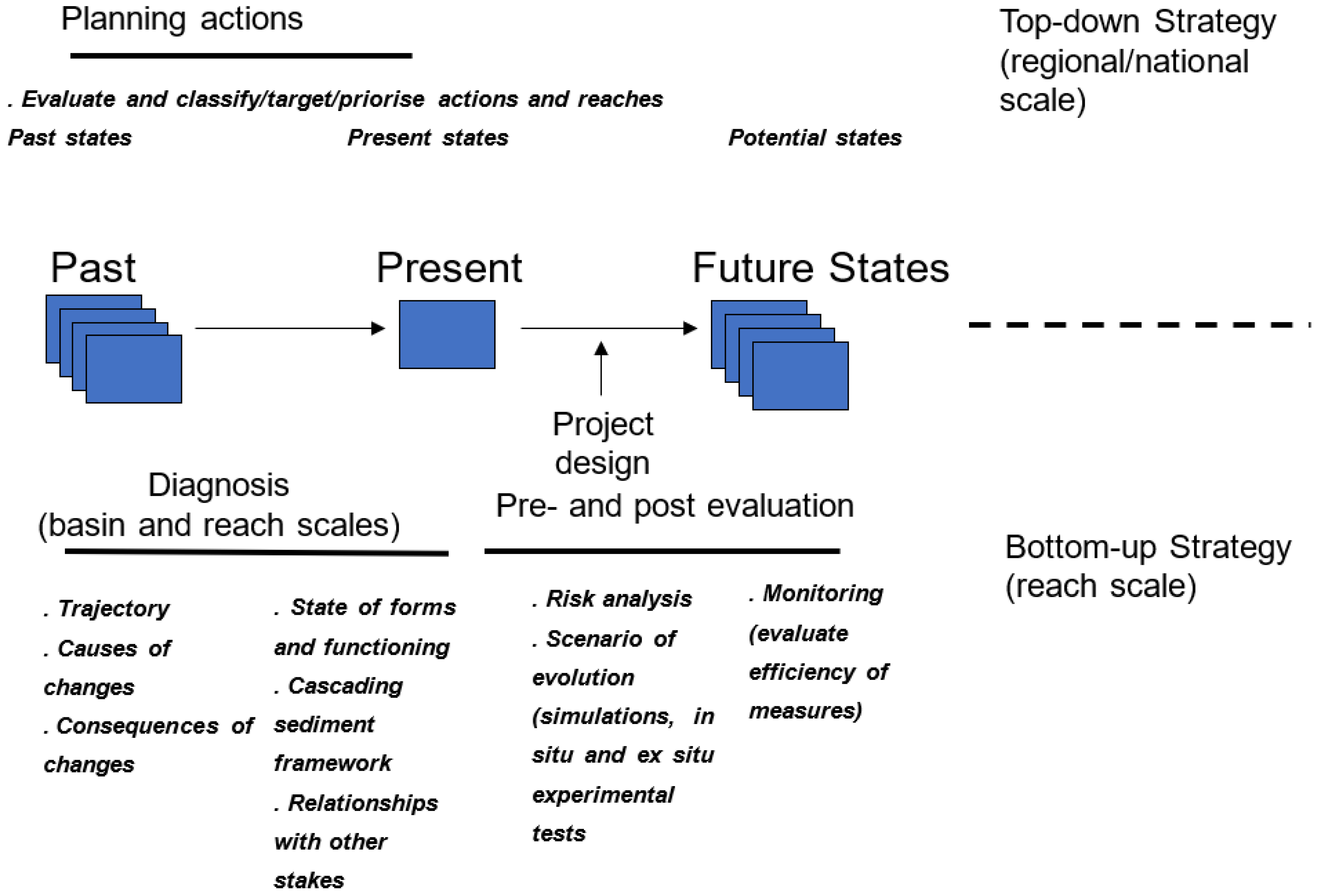

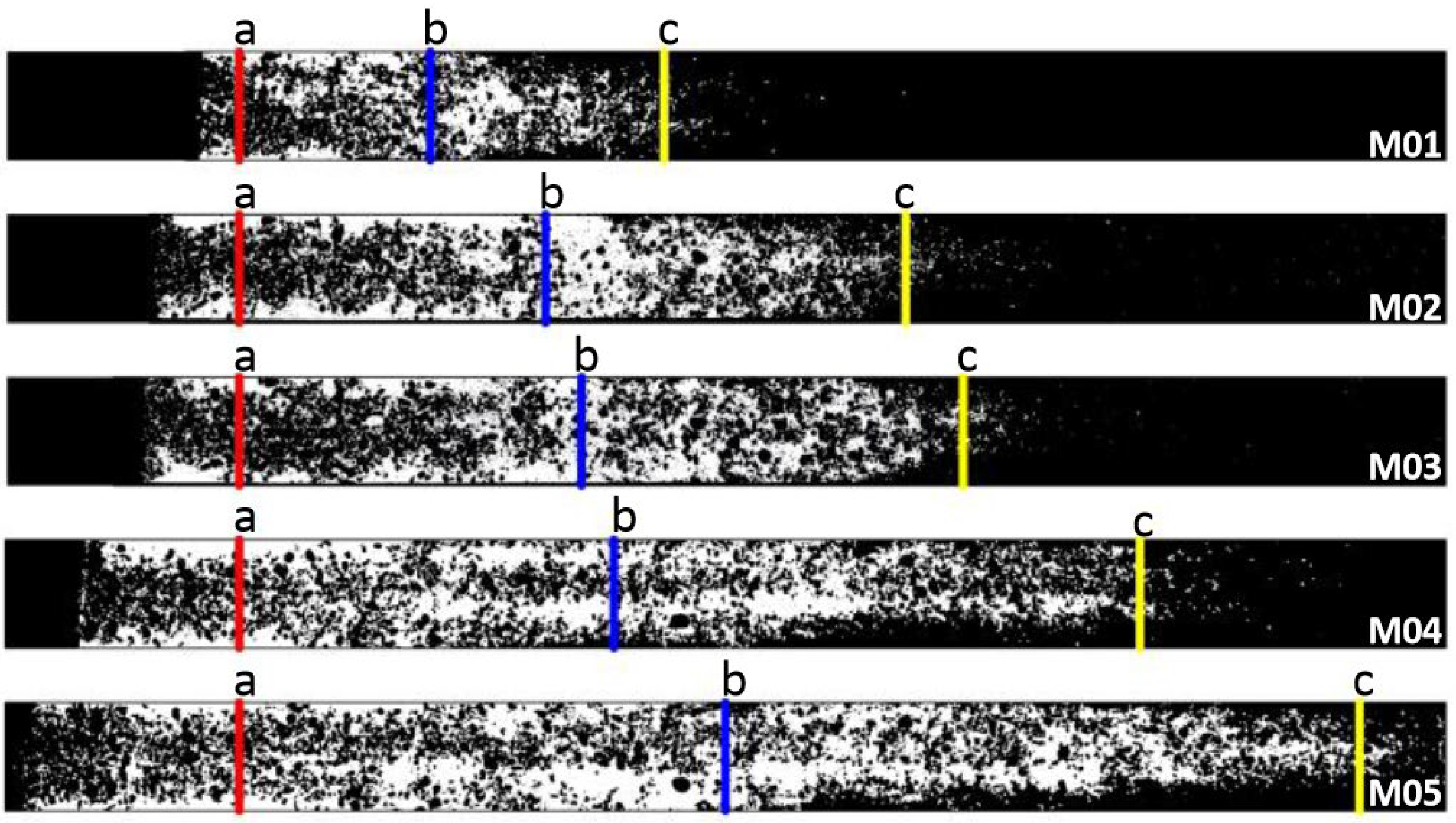
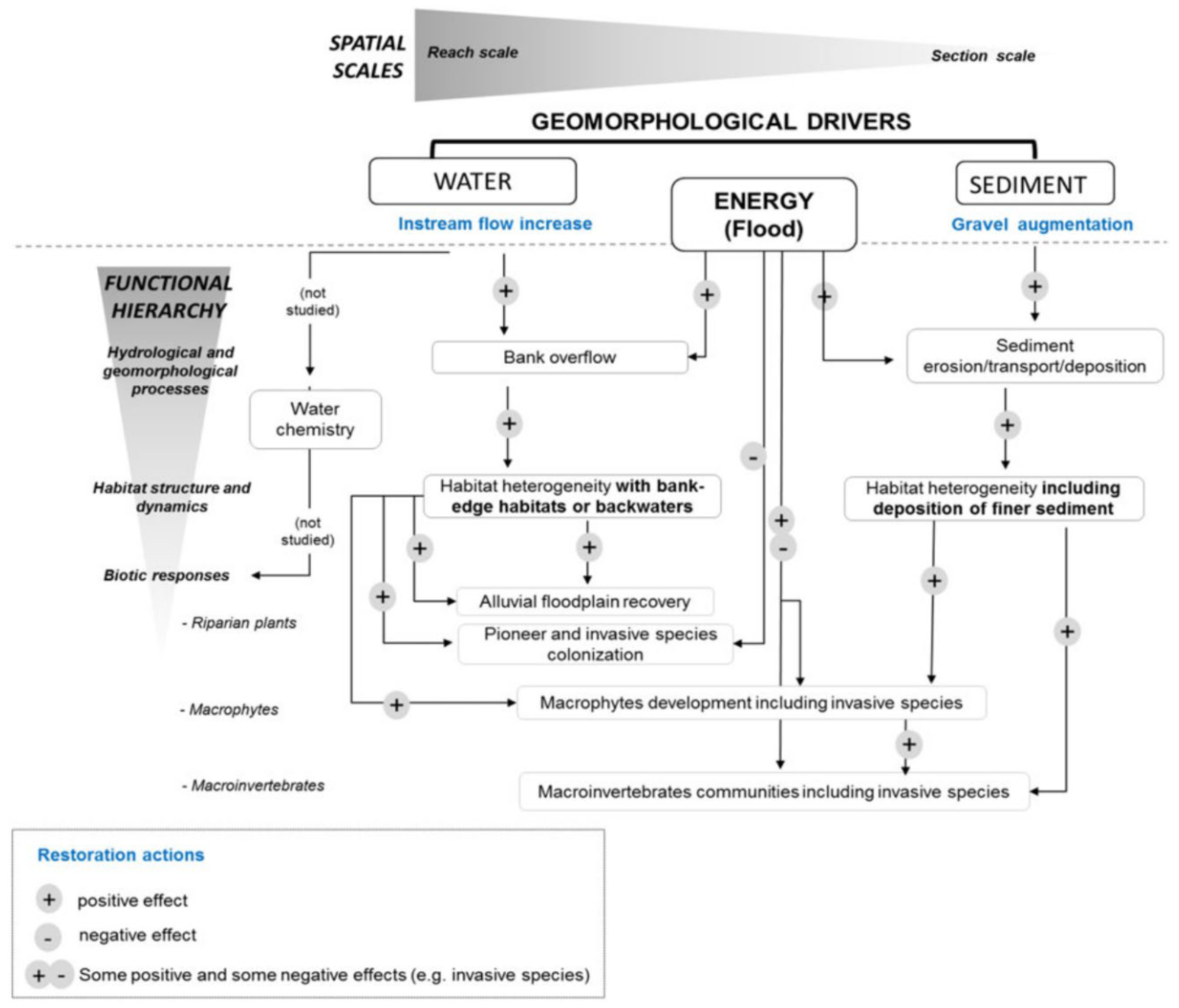
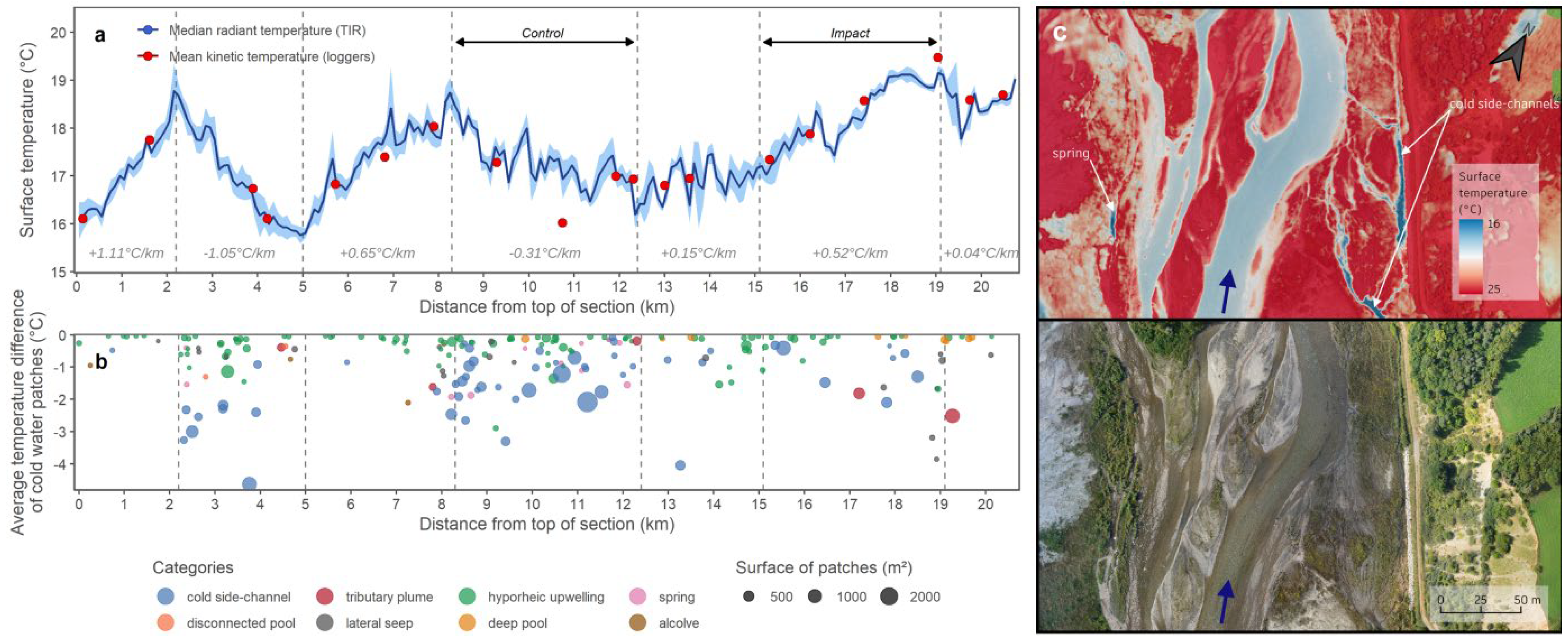

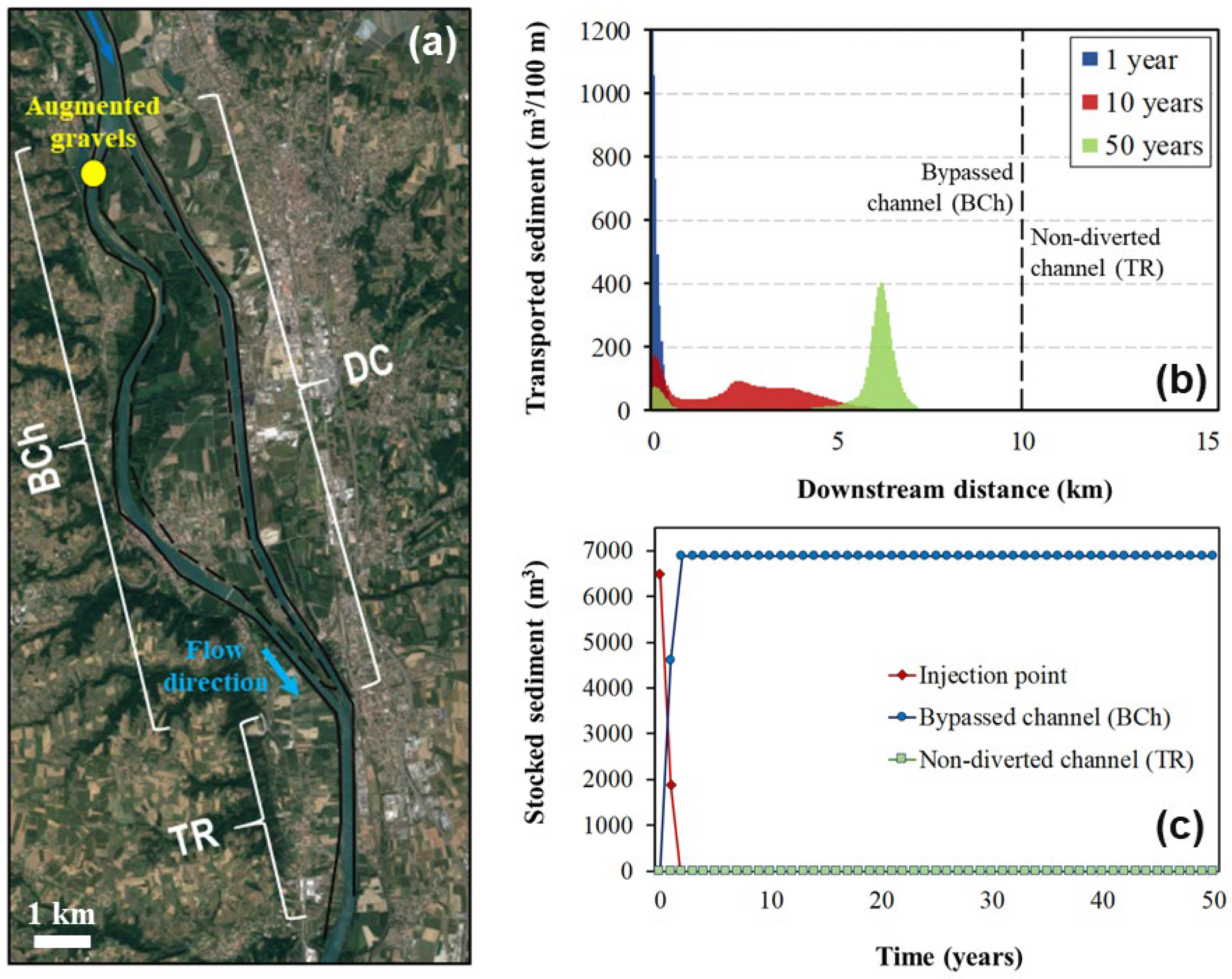
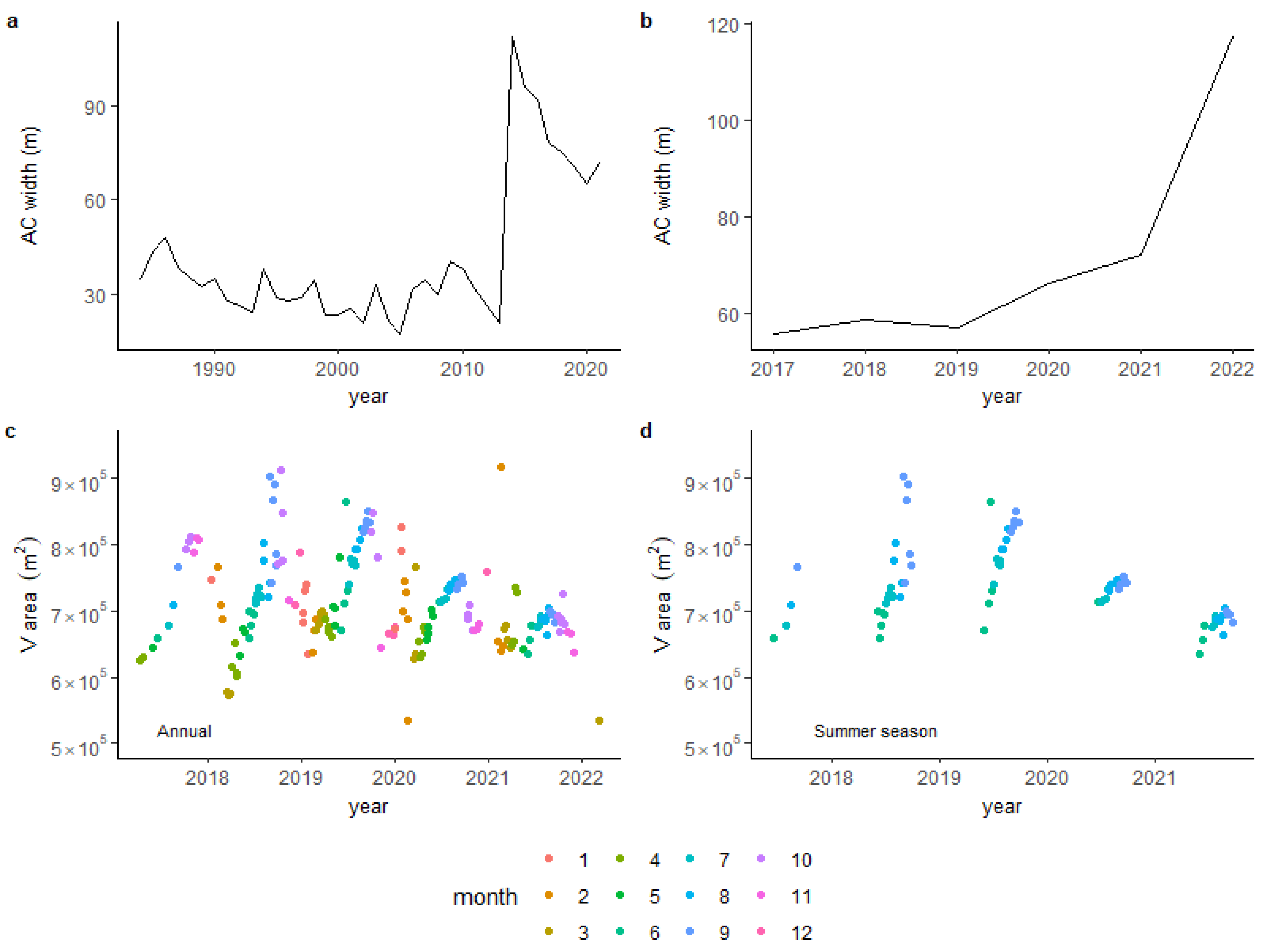

| Control Section | Rehabilitated Section | |
|---|---|---|
| Thickness of alluvial material | 10–15 m | ~3 m on average |
| Length of section | 3.9 km | 4.0 km |
| Average width (±1 S.D.) | 78 ± 27 m | 80 ± 30 m |
| Average slope | 0.0092% | 0.0107% |
| Braiding index * | 4.14 | 4.35 |
| Wetted width vs. active width ratio (R) | 0.24 | 0.49 |
| Normalised bed relief index * | 0.003 | 0.003 |
Disclaimer/Publisher’s Note: The statements, opinions and data contained in all publications are solely those of the individual author(s) and contributor(s) and not of MDPI and/or the editor(s). MDPI and/or the editor(s) disclaim responsibility for any injury to people or property resulting from any ideas, methods, instructions or products referred to in the content. |
© 2023 by the authors. Licensee MDPI, Basel, Switzerland. This article is an open access article distributed under the terms and conditions of the Creative Commons Attribution (CC BY) license (https://creativecommons.org/licenses/by/4.0/).
Share and Cite
Piégay, H.; Arnaud, F.; Belletti, B.; Cassel, M.; Marteau, B.; Riquier, J.; Rousson, C.; Vazquez-Tarrio, D. Why Consider Geomorphology in River Rehabilitation? Land 2023, 12, 1491. https://doi.org/10.3390/land12081491
Piégay H, Arnaud F, Belletti B, Cassel M, Marteau B, Riquier J, Rousson C, Vazquez-Tarrio D. Why Consider Geomorphology in River Rehabilitation? Land. 2023; 12(8):1491. https://doi.org/10.3390/land12081491
Chicago/Turabian StylePiégay, Hervé, Fanny Arnaud, Barbara Belletti, Mathieu Cassel, Baptiste Marteau, Jérémie Riquier, Christophe Rousson, and Daniel Vazquez-Tarrio. 2023. "Why Consider Geomorphology in River Rehabilitation?" Land 12, no. 8: 1491. https://doi.org/10.3390/land12081491
APA StylePiégay, H., Arnaud, F., Belletti, B., Cassel, M., Marteau, B., Riquier, J., Rousson, C., & Vazquez-Tarrio, D. (2023). Why Consider Geomorphology in River Rehabilitation? Land, 12(8), 1491. https://doi.org/10.3390/land12081491






